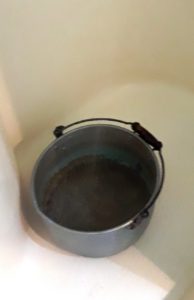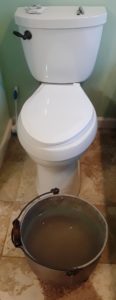Most folks agree: Water conservation is vital, since water is the most important resource on the planet. Having running water is almost as important. Wasting water is something that’s bothered me since I was a teenager. Becoming an independent water user was one of the first items on my “to do” list when I moved into rural Northwest Georgia.
There’s history: After my grandma got rid of her outhouse, she had a septic system. So did my dad and mom. But because they lived on Lake Winneconne in Wisconsin, they couldn’t have a drainfield. They had to have their septic holding tank pumped out. That was expensive AND bothersome. So we were always taught to save water: “If it’s yellow, let it mellow. If it’s brown, flush it down!” and “In these isles of sun and fun, we never flush for number one!” were signs in our bathrooms. During the summer, we usually bathed in the lake.
That water conservation feeling carried over into adulthood. During droughts in Seattle (yes, they happen!) I would water my flower garden and small lawn with “grey water” by keeping (used) bath and shower water in the tub. We’d also use that water to flush our toilets.
Which brings me to today. We’re out in the country, so we have a water well. AND we have a septic system / drain field. So, we have all the water we want, right? And we can dispose of as much as we want, right?
Not so fast.
Water is STILL a valuable resource. Water conservation is still an important practice.
I still can’t waste water. Even if I’m on a well, the less I use, the better. Even if I’m on a septic / drain field system, the less I “flush away” or drain away, the better. At least, that’s how it feels to me.
 That’s where the bucket comes in.
That’s where the bucket comes in.
A Bucket To Save Water And Reduce Waste Water
I have a large metal bucket. It’s got a wood handle, a pouring spout, and a tipping handle. It’s perfectly balanced to not spill. What’s that got to do with saving water?
I put the bucket in the shower stall when I shower. Yes, I have to straddle it a little. Sometimes I may even stand with my feet in the water bucket.
 I position the bucket so that the water running off my body flows (mostly) into the bucket. By the end of my shower, I have about 5 gallons of water that would have otherwise gone down the drain.
I position the bucket so that the water running off my body flows (mostly) into the bucket. By the end of my shower, I have about 5 gallons of water that would have otherwise gone down the drain.
Water Conservation Step 2: Toilet Flushing
After my shower, I move the bucket next to the toilet (I usually put it in the tub, which we rarely use). Then, whenever I need to flush the toilet, I simply pick up the bucket and pour a couple of gallons of my “grey” shower water forcefully (to “flush”) (but not so much that it splashes!) into the toilet bowl.
Voila! Whether yellow or brown, that waste goes down! Even though my toilet is a Kohler high efficiency model (1.6 gallons per flush), I still am using water that would otherwise be taking up space in the septic system. Grey shower water serves double duty for my duty!
Yes, it’s a small thing. But do the math. I get about 2 or 3 flushes per bucket. That saves about 3 gallons a day. 3 gallons x 365 days in a year … that’s saving over 1000 gallons of water a year! And that’s just me. (I haven’t gotten the rest of my family converted to that water conservation practic yet.)
I don’t know what difference it will make in my well water levels, if any. I don’t know if it will make a huge difference in my drain field. After all, I live northwest Georgia, a place that has rain, a place that is usually green much of the year. But I do know that if every one of Los Angeles’, Las Vegas’, Phoenix’s, Salt Lake City’s or Denver’s residents were to do that, especially during a drought year, that would add to billions of gallons of water saved.
And that makes a difference somewhere!
PS: For those of you who use government-supplied (city) water and sewer, how much of a difference would it make in your annual bill to use 1000 fewer gallons a year, and have 1000 gallons a year less in sewage / wastewater treatment costs? Something to think about!
